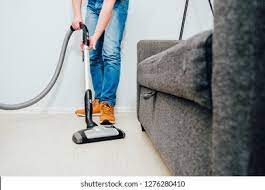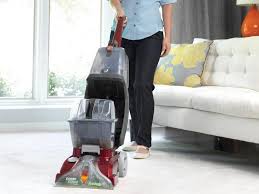1) Set your vacuum at the proper height
A. If your vacuum is set too low, you can damage the carpet as well as the vacuum’s roller brush and drive belt. If it’s set too high, you won’t pick up any dirt. To set the vacuum’s ideal height, raise it to its highest setting, turn it on and lower it until you can feel the vacuum trying to tug itself forward as you begin a how to clean carpet project.
B. Vacuum often
To protect your carpet, vacuum entrance areas and high-traffic areas twice a week and the rest of the carpeting at least weekly. Oily soils attract oily soils, and frequent vacuuming will reduce soil buildup.
C. Start with a clean bag or filter
A dirty bag, dirt cup or filter can cut a vacuum’s suction power in half. The main reason bagless vacuums stop working is that the filters aren’t changed often enough. Replace or wash (if possible) the filters on bagless vacuums every three months. Replace vacuum bags when they’re three-quarters full.
D. Vacuum at the right speed
Vacuum slowly enough to get out as much dirt as possible. Make one quick pass over low-traffic areas and two slow passes over high-traffic areas. Two slow passes removes ground-in dirt more effectively than several fast passes.

E. Use walk-off mats
Use walk-off mats inside and out to keep dirt off the carpeting. Coarse-textured mats outside your doors remove soil and will make a how to clean carpet project easier. Water-absorbent mats inside prevent wet shoes on the carpeting.

2A.) How to Use a Carpet Shampooer: Use DIY machines carefully
Hurrying through a cleaning will leave soap residue, a soaked carpet and a pad that can mold or mildew. Larger rental machines require you to pull them across the floor rather than push.
Carpet pros do a more thorough job than you can, but hiring a pro is expensive. So the next-best approach is to alternate between DIY and pro cleanings. DIY “steam”-cleaning machines can be effective if you understand how to use them and take the time to clean your carpet carefully.
You can rent a steam cleaner from a grocery store or home center. If you pick the machine up late in the day, many stores will charge you a half-day rate and let you keep the machine until the next morning. The detergent cost is additional. Typically you should use a tablespoon or less per gallon of water.
In the event you buy a steam-cleaning machine, plan to spend $60 to $300 or more. The pricier models have more powerful water jets and suction, and some even have a heating element to keep the water hot. The reviews on these machines are mixed, and some are prone to breakdowns. Do some online research (type “carpet cleaning machines” into your browser) before you buy.
Most rental machines weigh more, hold more water and come with a wider wand than purchased models, making them useful for larger, high-traffic areas. Purchased models are usually smaller, more portable and easier to store. They’re good for spot cleaning and are easier to drag up and down stairs. Whether you rent or buy, avoid damaging your carpets and make your cleaning last longer by following our how to clean carpet tips.
B. Clean the carpet before it becomes really dirty
How often your carpet needs cleaning depends on the kind of carpet traffic you have (think kids and pets). Clean the carpet when the color starts looking dull. If you wait until the carpet is filthy, cleaning it will be much more difficult, take much longer and cost more.
C. Ensure to Vacuum well before and after cleaning
Vacuum beforehand to remove large particles of soil. Vacuum again after you clean and the carpet is completely dry to pick up soil that wicks to the surface during drying.
D. Pretreat stains and high-traffic areas
Mix a drop of detergent with hot water in a spray bottle and lightly mist the dirtiest areas. Let sit 5 to 10 minutes before starting the general cleaning.
E. Remove or elevate furniture
To move heavy furniture, put aluminum foil squares, wood blocks or plastic film under and around the legs of all furniture to prevent rust from metal casters or stains from paint and finishes from transferring to damp carpet.
F. Don’t overwet the carpet
DIY machines put a lot of moisture into the carpet, and most don’t have strong enough suction to extract it thoroughly. Make only one pass with the soap and water solution. Make one pass with the neutralizing rinse solution. Then make two or three drying passes with the water off.
G. Let it dry thoroughly
Wet carpet is a perfect environment for mold and mildew. After you clean your carpets, open the windows, use fans and a dehumidifier, or put the AC on a moderate setting (72 to 78 degrees) to remove excess moisture from the air. Don’t replace the furniture or walk on the carpet until it’s completely dry. This can take up to 12 hours, though six to eight hours is typical.
3A.) How to Spot Clean Carpet: Don’t dig or scoop food spills
Digging or scooping can work the stain into the carpet. If there are solids on top of the stain, use a spoon or dull knife to carefully scrape the food toward the middle of the spill and into a white towel and then treat the stain.
B. How to Spot Clean Carpet: Act quickly
We suggest you get to a stain immediately, there’s a 99 percent chance you can remove it. The longer a stain reacts chemically with the carpeting, the harder it is to remove.
C. How to Spot Clean Carpet: Try water first
Eighty percent of stains can be removed using plain tap water. To remove a stain, press a clean, dry, white cloth over the stain to absorb the spill. Repeat until the spill is absorbed. Then gently work water into the stain with a damp white towel and blot until the stain is gone. Change cloths when necessary. For a particularly stubborn spot, go to the online “spot solver” resource at The Carpet and Rug Institute (the carpet manufacturers’ trade organization) to find your stain and a suggested solution. Use a fan to dry the area if it’s very wet.
D. How to Spot Clean Carpet: Blot—don’t rub or scrub
Scrubbing a stain will damage the fibers and create a fuzzy area. Always blot from the outer edge toward the center of the stain to avoid spreading the spot and creating a larger problem.
E. How to Spot Clean Carpet: Be patient
Work water gently into the spill and then blot with a dry cloth. Repeat until the stain is gone and all the water has been absorbed. If you’re patient, you’ll almost always be able to remove the stain.
F. How to Spot Clean Carpet: On tough spots, try vinegar or club soda
If water alone doesn’t remove a stain, try a white vinegar and water solution (equal amounts) or club soda before trying stronger commercial cleaning products.
G. How to Spot Clean Carpet: Test commercial products first
Some products can cause carpet to get dirty faster or damage the carpet’s color and texture. For a list of carpet manufacturer- approved spot and stain cleaners, go online to The Carpet and Rug Institute. Test carpet-cleaning products on an inconspicuous area before using.

ADDITIONAL INFORMATION
Required Tools for this How to Clean Carpet Project
You’ll need a good vacuum cleaner as well as a shop vacuum, sponges, and a DIY steam-cleaning machine for this how to clean carpet project.
Required Materials for this How to Clean Carpet Project
Avoid last-minute shopping trips by having all your materials ready ahead of time for this how to clean carpet project. Here’s a list.
- Carpet-cleaning soap
- Indoor and outdoor floor mats
- Paper towels
- Spot treating cleaners
- Vacuum filters
